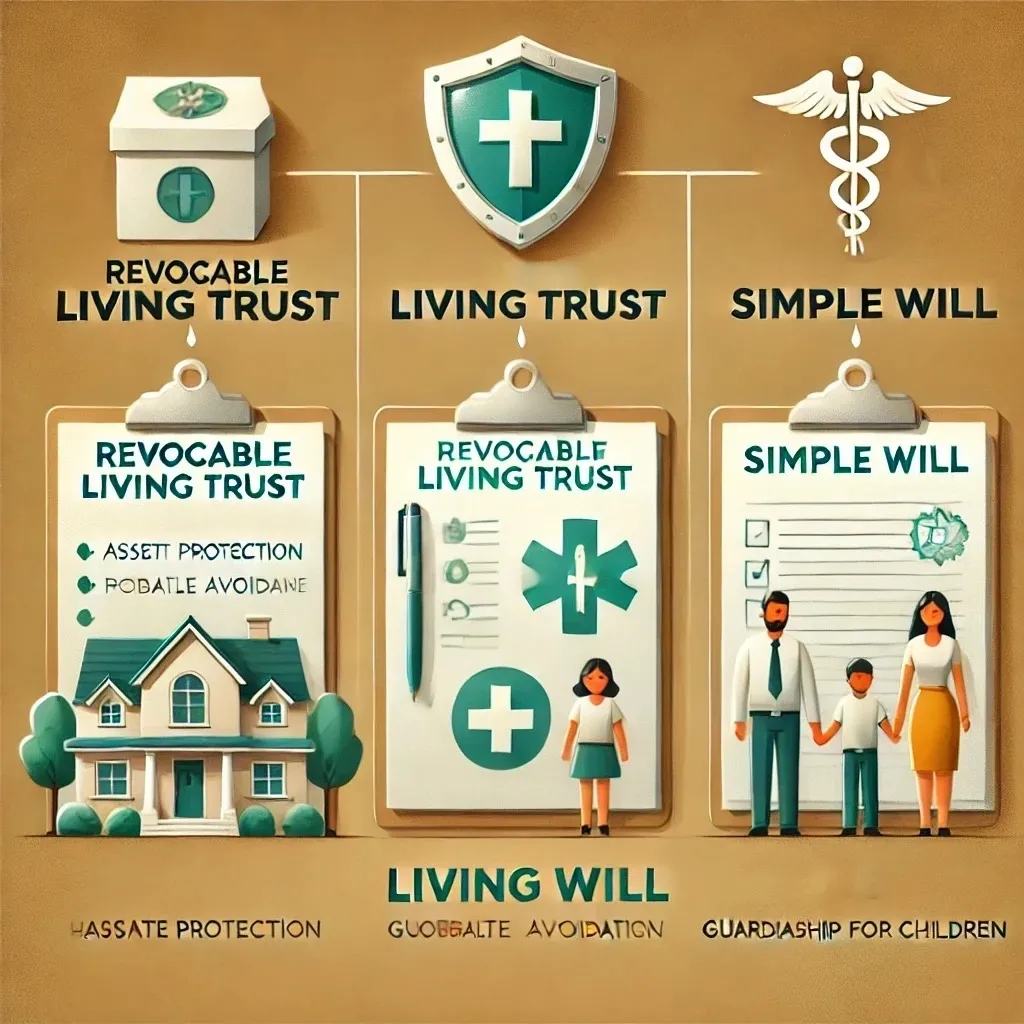If you’re exploring estate planning, you’ve likely heard of revocable living trusts, living wills, and simple wills. While these terms sound similar, they serve very different purposes. Each plays a unique role in managing your assets, ensuring your wishes are honored, and protecting your loved ones.
As a firm offering estate planning in Oregon, Washington, and California, and nationwide asset protection services, we’re here to break down the differences, explain how they work together, and provide real-life examples to make it easy to understand.
What Is a Revocable Living Trust?
A revocable living trust is a legal arrangement where you transfer ownership of your assets into the trust while retaining control during your lifetime. The term “revocable” means you can modify or dissolve the trust at any time.
Key Features of a Revocable Living Trust:
• Avoids Probate: Assets in the trust bypass the probate process, saving your family time, money, and stress.
• Manages Assets During Incapacity: If you become incapacitated, a successor trustee can take over without court involvement.
• Customizable Asset Distribution: You can decide how and when beneficiaries receive their inheritance, such as staggered payments or specific milestones.
What Is a Living Will?
A living will, also known as an advance healthcare directive, outlines your preferences for medical care if you are unable to communicate. Unlike a revocable living trust, a living will focuses exclusively on medical decisions, not financial matters.
Key Features of a Living Will:
• Medical Care Preferences: Specifies your wishes for life-sustaining treatments, ventilators, feeding tubes, and organ donation.
• Appoints a Healthcare Proxy: Names someone to make medical decisions on your behalf if you’re incapacitated.
• Applies During Incapacity Only: A living will takes effect only if you’re unable to communicate your medical wishes.
What Is a Simple Will?
A simple will is a legal document that outlines how your assets should be distributed after your death and allows you to name guardians for your minor children. However, unlike a revocable living trust, a simple will does not avoid probate.
Key Features of a Simple Will:
• Distributes Assets After Death: Specifies who will inherit your property, such as your home, bank accounts, and personal belongings.
• Names Guardians for Children: Allows you to designate someone to care for your minor children.
• Goes Through Probate: Assets distributed via a will must go through probate, which can be costly and time-consuming.
Examples to Illustrate the Differences
Meet David: Planning for His Family’s Future
David is a 45-year-old father of two who lives in California. He owns a home worth $1.2 million, has $400,000 in savings, and runs a small business. He wants to ensure his family is cared for if something happens to him.
1. Revocable Living Trust
David creates a revocable living trust and transfers his home, savings, and business ownership into it.
• He names himself as the trustee, maintaining control during his lifetime.
• He designates his sister, Lisa, as the successor trustee, who will manage the trust if he becomes incapacitated or passes away.
• The trust specifies that his children will receive their inheritance in stages—50% at age 25 and the remaining 50% at age 30.
2. Living Will
David drafts a living will that outlines his medical preferences.
• He states that he does not want to be kept on life support if he is in a persistent vegetative state.
• He appoints Lisa as his healthcare proxy to ensure his wishes are followed.
3. Simple Will
David also creates a simple will to:
• Name a guardian for his two children in case something happens to him.
• Address personal belongings not included in the trust, such as sentimental items or heirlooms.
How the Documents Work Together
A year later, David is injured in a car accident and falls into a coma. Here’s how his estate plan protects his family:
• Living Will: Doctors consult David’s living will to guide his medical care, and Lisa ensures his preferences are honored.
• Revocable Living Trust: Lisa, as successor trustee, manages the trust assets to cover medical bills, pay household expenses, and maintain the business.
• Simple Will: Although David survives, his will ensures his children’s guardianship and personal items are accounted for in case of future emergencies.
When David passes away 15 years later, the trust bypasses probate, and his children receive their inheritance according to his wishes.
Why You Need All Three
Each of these documents plays a distinct role in protecting your family and honoring your wishes:
1. Revocable Living Trust: Avoids probate, manages assets during your lifetime, and ensures efficient distribution after death.
2. Living Will: Guides medical care during incapacity, ensuring decisions align with your values.
3. Simple Will: Names guardians for minor children and addresses assets not included in the trust.
Together, they form a comprehensive estate plan that protects your assets, health, and loved ones.
Who Needs a Revocable Living Trust?
A revocable living trust is especially beneficial for:
• Families with minor children to ensure their inheritance is managed responsibly.
• Homeowners in states with costly probate processes, such as California.
• Individuals with estates subject to state estate taxes, such as in Oregon or Washington.
• High-net-worth individuals seeking asset protection planning nationwide.
Take the First Step Toward Peace of Mind
A comprehensive estate plan is essential for protecting your family, avoiding probate, and ensuring your wishes are honored. Whether you need estate planning services in Oregon, Washington, or California, or nationwide asset protection, our experienced attorneys can help.
Contact us today at (888) 773-9399 to create a customized estate plan, including a revocable living trust, living will, and simple will. Let us guide you in protecting your legacy and securing your family’s future.
By: Brian T. Bradley, Esq.




